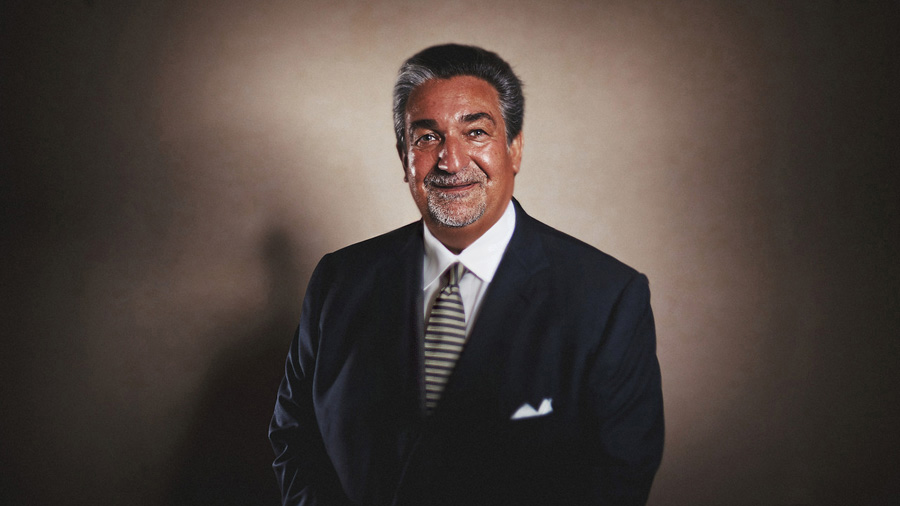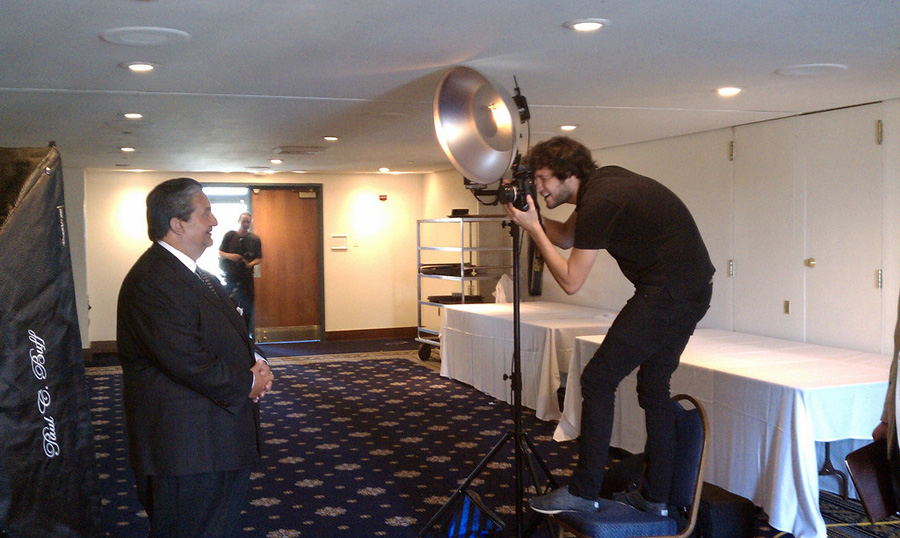
Ted Leonsis – July 18th 2011
The Gear
Lens: Nikon 50mm f/1.2
Camera: Nikon D3s
Technique: The Brenizer Method
Strobist Information
Light Sources: 2 Einstein 640 WS by Paul C. Buff
Light Modifiers: Key light is a 22″ silver beauty dish – camera right. Rim light is a gridded 10″ x 36″ Stripbox – camera left.
The Goal
Create a compelling portrait in 30 seconds while making life difficult for myself.
The Vision
For my very first portrait I had grand ideas. Being an obsessed follower of NYC based photographer Ryan Brenizer I accumulated a few tricks up my sleeve to make dull atmospheres suddenly interesting and I wanted to use them all. Namely… the Brenizer Method. For those of you that aren’t familiar with the technique it’s pretty awesome and you can read more about it here from the man himself.
Yes, I decided to photograph this image as a panorama using a razor thin dof f/1.2 manual focus lens through a dark 10x ND filter while standing on a chair. But I wanted this photo to look like it was taken on a medium format camera and I wanted the background to be totally bokehlicious.
The Story
So, for this photo I knew I’d have around 30 seconds of actual face time with my very first subject. Thankfully, he just so happens to be the coolest most friendly man I’ve come across in a long time… Ted Leonsis. The owner of the Washington DC Caps and Wizards who made a fortune in AOL years ago. Big money. I had a vague sense of the lighting I wanted to go for and of course I was going to push myself in at least one way – brenizer method it with the nikon 50 1.2. This would do 3 things for me.
1) Quickly prove weather taking a quick series of 10 or so images would freak people out.
2) Show whether or not I could get the medium format look I wanted to achieve in my portraits.
3) Prove that if I could pull this off smoothly then all future portraits would likely be no problem.
My hands were shaking while holding the camera, however somehow I kept my cool. This was my very first time taking a portrait with the Einstein strobes, or any studio lit portrait for that matter. Why did I decide to use a large strobe that requires a power cable vs small and self sufficient nikon speedlights? Because of their modeling light capabilities. For all these portraits I will usually have only a few minutes with my subjects so literally every second counts and being able to see the direction of the light before I take the photo is absolutely curial.
Thing is… I didn’t have my pocket wizards setup properly. The modeling light config was still set to go to whatever exposure was set for the actual shot. Because I’m shooting wide open at 1.2 I have to use very slow flash power so my lights don’t over expose…. yes, even with a really dark ND filter. So, this caused the modeling light to dim very low as soon as I pushed the shutter button thus resulting in me being able to see absolutely nothing through the viewfinder. oops.
I’m incredibly lucky this shot came out in focus. I should also mention… literally 2 mins before Mr. Leonsis walked into the room I decided to give Paul C. Buff support a quick call from my cell to see if there was anything I could do to fix this issue on the units directly. It’s a testament to their support that I had my answer in less than 2 mins just as Mr. Leonsis was walking in… and that answer was: no… you can’t fix it without first reconfiguring my pocket wizards via my computer. Oh well.
Here is a snap of me in action and so you can get a sense of what I was working with.

The Lesson:
Overall, I love the portrait. Now that I have a sense of the entire process, the amount of setup time it takes, the amount of time I have with the subject, what my location might be like, and whether the brenizer method was doable/appropriate for celebs in bright lights… I can move onto other things. Namely… getting more interesting lighting. Yes, I want to work on my subject’s expressions and character too, but I’ve decided to take things one step at a time. The next portrait won’t be so technically involved from the camera side. Once I can learn these lights like I have learned my cameras and lenses I can concentrate on connecting with my subjects and getting interesting and surprising expressions. Before I can do that I have to know my lights inside and out so it’s not even a thought to make a change or address a problem.
One other thing I did not anticipate was how shiny he’d be… and I should have. I photographed him before many months earlier, however totally candid. The guy is greek so his skin is just going to naturally have that kind of look to it. Oh well, this was taken in 30 seconds. I had no second chances. I kept the lighting somewhat simple, but I was very happy with the spooky and dramatic background going on.
Also, I need to take more setup shots!

Wow, this is so interesting! Love reading about your thought process, all the challenges with timing and equipment, and seeing the result. Awesome!
Really enjoy your work. Thanks for posting this behind the scenes look. Hope you keep it up. It’s a good read. Thanks for sharing.
Dude, thanks so much for posting this. I really enjoyed reading it and the image is stellar.
yup, epic. i love buff gear! ryan would be proud!
I am flattered– a friend sent me this link; an interetsing shot indeed; thank you. Ted
[…] learned a lot in my first epic portrait. Opposite what I said I’d do I decided to keep the lighting largely the same and work more on […]
I came across this shot on your website looking for reviews of Nikon’s 50mm 1.2 lens. I have to say that this is one of the most impressive portraits I’ve seen in quite some time. The use of the Brenizer method is really quite spectacular here. I experimented with it last spring trying to find a way to adequately capture interesting ‘spaces’ in forests which I was having a hell of a time with in single exposures. While the Brenizer method isn’t something I use very much, it was a real awakening for me and changed the way I perceive and approach photography. I’ve been in the dreaded winter creative-slump for the past couple months and seeing this portrait really reminded me how much I love photography and I’m finally inspired to get off my ass and start shooting again.
Anyway sorry for the novel and thanks for the inspiration. Great photo! I might just buy the 1.2 after all.
Amazing. But I’m wondering why you need a 10x ND filter shooting with the einsteins? Can’t you kill the ambient with just one or two stops ND and use the super low flash output of the Einsteins?
Kevin- I don’t want to put words into Sam’s mouth but I assume he went with the 10X ND because shooting at f1.2 the Einsteins -even at their lowest setting- still have a lot of power. Why shoot at f1.2? He wanted for the shallow depth of field & Brenizer method look (though it’s usually done with a longer lens).
[…] interesting side note is that this is the second time I’ve photographed in this exact same spot. Comparing the two images it’s really fascinating for me to see how my work has evolved from […]
They look great, one thing I don’t anderstand is why use the brenizer method with a relatively wide 50mm lens and super fast 1.2 appeture, it is more than you would get on medium format